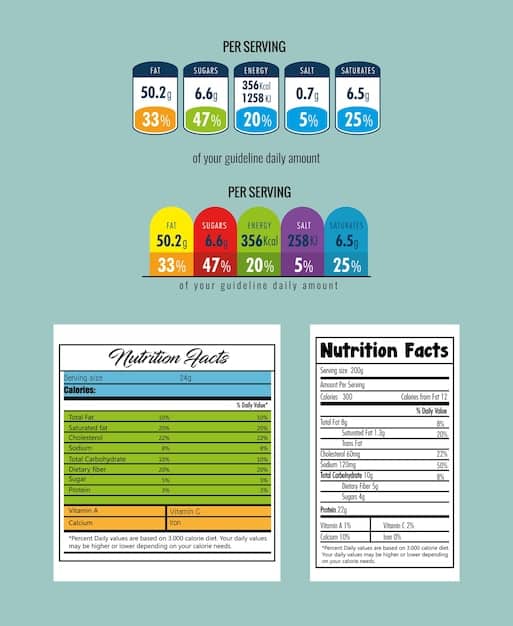Decoding Baby Food Labels: Your 2025 Guide

Decoding Baby Food Labels in 2025 is crucial for parents seeking the healthiest options for their children; this guide provides essential insights into understanding ingredients, nutritional information, and potential allergens, ensuring informed decisions for your baby’s well-being.
Navigating the aisles of baby food can feel overwhelming. Labels are packed with information, but understanding what it all means is essential for making informed choices about your child’s nutrition. This guide to decoding baby food labels: what you need to know in 2025 will empower you to decipher the jargon and choose the best options for your little one’s health and development.
Understanding the Basics of Baby Food Labels
Baby food labels are designed to provide parents with comprehensive information about the product’s ingredients, nutritional content, and safety. These labels have evolved to meet the growing demands for transparency and healthier options.
Key Information on Baby Food Labels
Understanding the essential components of a baby food label is the first step in making informed decisions.
- Product Name: Identifies the type of food and any specific ingredients.
- Ingredient List: Lists all ingredients in descending order by weight.
- Nutritional Information: Provides details on nutrients like vitamins, minerals, and macronutrients.
- Expiration Date: Indicates the ‘use by’ or ‘best before’ date for optimal freshness and safety.
The ingredient list is a crucial section to pay attention to. It tells you exactly what is in the baby food, and in what proportion. Look for whole foods and avoid products with excessive additives or preservatives.

Understanding the basics of baby food labels empowers parents to select the best products for their child’s health and well-being, ensuring transparency and informed decision-making.
Decoding the Ingredient List: What to Watch For
The ingredient list is the most important section on any food label. For baby food, it’s especially critical because babies have sensitive digestive systems.
Prioritizing Whole Foods
Focus on products with short ingredient lists consisting of whole, recognizable foods.
- Fruits and Vegetables: Look for specific fruits and vegetables listed as primary ingredients.
- Grains: Opt for whole grains like brown rice, quinoa, or oats.
- Proteins: Choose foods with lean proteins such as chicken, fish, or legumes.
Ingredients to Avoid
Certain ingredients can be detrimental to your baby’s health and should be avoided.
- Added Sugars: Including corn syrup, sucrose, or fructose.
- Artificial Flavors and Colors: These additives offer no nutritional value and may cause adverse reactions.
- Preservatives: While some are harmless, excessive preservatives can be concerning.
By prioritizing whole foods and avoiding harmful additives, parents can ensure their babies receive optimal nutrition from their food choices.
Navigating Nutritional Information: Vitamins, Minerals, and Macronutrients
The nutritional information panel provides a detailed breakdown of the nutrients present in the baby food. Understanding this section helps you ensure your baby receives a balanced diet.
Essential Nutrients for Baby Development
Babies require a variety of nutrients to support their rapid growth and development.
- Vitamins: Including A, C, D, and E for immune function, vision, and bone health.
- Minerals: Such as iron, calcium, and zinc for blood health, bone development, and immune support.
- Macronutrients: Including carbohydrates, proteins, and fats for energy and overall growth.
Understanding Percent Daily Value (%DV)
The %DV indicates how much of a nutrient is provided in one serving of the food.
Pay attention to the %DV for key nutrients like iron and calcium. Aim for foods that provide a significant percentage of the daily recommended intake to support your baby’s health.

Careful examination of the nutritional information panel ensures that babies receive a well-rounded diet, supporting their growth and development with essential vitamins, minerals, and macronutrients.
Organic vs. Non-Organic: What’s the Difference?
The choice between organic and non-organic baby food is a common dilemma for parents. Understanding the differences can help you make an informed decision.
Benefits of Organic Baby Food
Organic baby food offers several advantages.
- Pesticide-Free: Organic farming prohibits the use of synthetic pesticides, reducing your baby’s exposure to potentially harmful chemicals.
- Non-GMO: Organic products cannot be genetically modified, ensuring your baby consumes natural foods.
- Environmentally Friendly: Organic farming practices promote soil health and biodiversity.
Considerations for Non-Organic Baby Food
Non-organic baby food can still be a safe and nutritious option.
- Rigorous Testing: Both organic and non-organic baby foods undergo testing to ensure they meet safety standards.
- Cost-Effective: Non-organic options are typically more affordable.
- Nutritional Value: Both organic and non-organic foods can provide essential nutrients for your baby.
Ultimately, the decision between organic and non-organic baby food depends on individual priorities and budget. Both options can provide the nutrition your baby needs to thrive.
Understanding Allergen Labeling: Protecting Your Baby
Allergens are a significant concern for parents, especially when introducing new foods. Proper allergen labeling is essential for protecting your baby from potential reactions.
Common Allergens in Baby Food
The most common allergens in baby food include:
- Milk: Found in dairy-based products.
- Eggs: Present in some purees and mixed foods.
- Peanuts and Tree Nuts: Often found in snack foods.
- Soy: Used in various processed foods.
How to Read Allergen Statements
Allergen statements are typically found near the ingredient list.
Look for clear statements such as “Contains: [Allergen]” or “May contain: [Allergen].” Introduced new foods one at a time and watch for any signs of an allergic reaction, such as rash, hives, swelling, or difficulty breathing.
Understanding and carefully reading allergen statements helps parents protect their babies from allergic reactions, ensuring a safe and healthy introduction to new foods.
Decoding “Clean Label” Claims: What Do They Really Mean?
“Clean label” is a marketing term that has gained popularity, but it lacks a standard definition. Understanding what “clean label” claims really mean can help you make more informed choices.
Interpreting “Clean Label” Claims
“Clean label” products generally focus on:
- Minimal Processing: Foods that have undergone minimal processing and retain their natural qualities.
- Simple Ingredients: Products with short ingredient lists consisting of recognizable foods.
- Transparency: Clear and honest labeling practices.
Evaluating “Clean Label” Products
When evaluating “clean label” products:
- Read the Ingredient List: Ensure the product contains whole, recognizable foods.
- Check for Additives: Look for the absence of artificial flavors, colors, and preservatives.
- Consider the Source: Research the brand and its commitment to transparency.
Decoding “clean label” claims requires careful evaluation of the ingredient list and overall product information, ensuring parents make informed decisions about the food they feed their babies.
| Key Point | Brief Description |
|---|---|
| 🍎 Ingredient List | Prioritize whole, recognizable foods. Avoid added sugars and artificial additives. |
| 📊 Nutritional Info | Ensure adequate vitamins, minerals, and macronutrients for baby’s development. |
| 🌱 Organic vs. Non-Organic | Organic minimizes pesticides. Non-organic is rigorously tested and more affordable. |
| ⚠️ Allergen Labeling | Read allergen statements carefully. Introduce new foods one at a time. |
Frequently Asked Questions
Organic baby food is produced without synthetic pesticides, GMOs, or chemical fertilizers. It adheres to specific farming and production standards, ensuring a more natural product for your baby.
Avoiding added sugars is crucial. They offer no nutritional value and can lead to unhealthy eating habits and potential dental problems. Always opt for naturally sweet options from fruits and vegetables.
If you suspect a food allergy, consult with your pediatrician or an allergist. They can perform tests to confirm the allergy and provide guidance on managing your baby’s diet safely.
Both have benefits. Homemade allows control over ingredients, while store-bought offers convenience and is often fortified with essential nutrients. Choose what best fits your lifestyle and nutritional needs.
Check for expiration dates, look for clear labeling, and research brands known for quality and safety standards. Choosing reputable brands and carefully reading labels can ensure safety.
Conclusion
Decoding baby food labels requires a thoughtful approach, focusing on ingredients, nutritional information, and potential allergens. By arming yourself with this knowledge, you can confidently select the best options for your baby’s health and development, ensuring they receive the nourishment they need to thrive.




